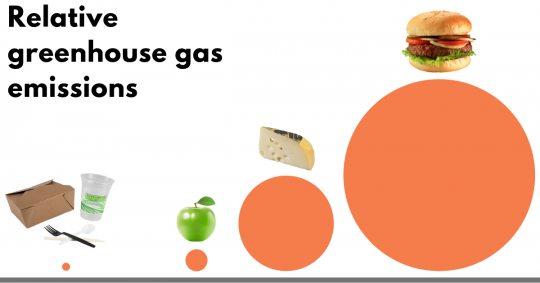News
What's the greenest disposable dishware?
There is not a single disposable product that is considered to be the best option. Each product's environmental impact varies depending on factors such as the material used, such as paper, plastic, or plants; how it's manufactured; how lightweight or heavy it is; and how it's packaged and transported.
The only way to know if one product is environmentally better than another is to run a full Life Cycle Assessment for each and compare the impacts that they have on the environment.
Here are some general tips:
1. Aim for "less product"
Less product means less environmental impact, so use as little packaging as possible, or choose lighter weight products that are made with less, often thinner, plastic or paper. For example:- Using thinner plastic produce bags still gets the job done, but with less plastic.
- Instead of offering pre-bundled disposable cutlery and napkins, let customers choose which items they want.
2. Look for products made from recycled materials
Products made from recycled materials are almost always environmentally better than those made from virgin content, as long as it is within the same material type. If you're looking for a paper drink cup, a recycled-content paper cup is better than a virgin paper cup. The same applies if you're looking for a plastic drink cup: recycled plastic is better than virgin plastic. The higher the percentage of recycled content, the better.
However, if you're looking for a drink cup and are considering both plastic and paper versions, it's less clear which one is better since there are so many variations in how paper and plastic are made. It might be that a recycled paper cup has a larger carbon footprint than a virgin plastic one, or vice versa. To know for sure, you'd need a Life Cycle Assessment comparison of each product.
3. Avoid labels that cause confusion
Avoid products whose labels lead customers and staff to make "best intention" mistakes that cause problems for local recycling and compost systems."Compostable" or "biodegradable" label
Products labeled "compostable" or "biodegradable" are not allowed in compost locally: They don't always break down in the compost, don't add nutrient value, and often lead to more paper products and plastics of all types contaminating the compost and the farms and gardens where the compost is used. (The only exception to this rule is compostable bags used to collect and transport food waste. However, these bags will be thrown away and not composted.)
Products labeled "biodegradable" or "compostable" should go in the trash. Even though some manufacturers promote their products' ability to break down in the landfill, when things break down in the landfill, they produce methane, a potent greenhouse gas – so what sounds like a good thing actually isn't.
- Why local compost facilities do not want compostable packaging
- The truth about compostable packaging and food service ware
Biobased packaging is often promoted as an alternative to plastic packaging, which is derived from fossil fuels. But many of the currently available biobased materials are made from crops, such as corn, that rely heavily on fossil fuel-based inputs for growing, processing, and transportation.
To-go food packaging is not recyclable in Clark County: Disposable cups, cutlery, dishware and other to-go boxes and containers are all trash, regardless of what they're made of (plastic, paper, bamboo, etc.). The only exceptions to this rule are round plastic tubs, which are sometimes used for soup or deli foods, and tin or metal containers.
When people see the "recyclable" label, they're more likely to put the item in their recycling bin, where it will have to be screened out – causing cost and hassle for the recycling facilities.
Read more: The truth about recyclable packaging
4. Remember the bigger picture
Packaging is often top of mind for customers, because they're the ones that dispose of it. But the environmental impact of packaging is far less than the environmental impact of food.
The most impactful thing customers and businesses can do is make climate friendly food choices (more vegetables and whole grains, less meat and dairy) and to make the most of the food we buy (avoid wasted food through thoughtful purchasing, preparation and storage).Still confused? We get it.
If you have more questions, let us know, and we'll try to find answers for you.You're also welcome to dig into research about the environmental impacts of packaging from the Oregon Department of Environmental Quality, from which our information is sourced.
If you want to compare different products by their Life Cycle Assessments, there are software tools to help, such as COMPASS, PIQET, SimaPro, GaBi, or PackageSmart, but there is a charge to use them and the process can be time-intensive. You can always check out the open source software tool that you can use for free at openLCA.




